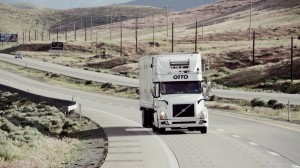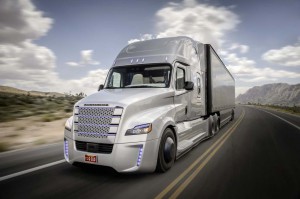
Autonomous trucking start up Otto broke new ground today by delivering a truckload of beer in Colorado.
Drinking and driving don’t go together. But what if you’re just hauling a load of beer from the brewery?
In a potentially groundbreaking first, Otto, a self-driving truck start-up, delivered a load of 45,000 cans of Budweiser to a warehouse in Colorado with no one behind the wheel. The 120-mile run is being hailed as the first in what could begin a routine way of life in the not-too-distant future as autonomous and fully driverless vehicles take over the highways.
The early morning delivery was set in motion by Budweiser parent Anheuser-Busch working with Otto, the start-up recently purchased by Uber. The ride-sharing giant has become a leading proponent of autonomous and fully driverless technologies, arguing that these systems will eventually make American roadways safer, faster and cleaner – while also lowering the cost of driving.
The test drive began at the Budweiser plant in Fort Collins, Colorado, and ended, about two hours later, at a warehouse in Colorado Springs, the vehicle averaging about 55 miles an hour. While there was no driver behind the wheel, there was a specialist seated in the truck’s sleeper berth to monitor things along the way. Eventually, the goal is to take humans out of the truck entirely.
How soon that could happen on a regular basis is far from certain. Otto and Anheuser-Busch were able to line up special permission from the State of Colorado to run the test drive – with state police vehicles monitoring the project closely. But Colorado, like most states, has so far specifically barred driverless vehicles from operating on public roads.
California regulators recently reversed themselves, announcing tentative rules that would allow the testing of driverless vehicles on highways.
A number of other states, including Florida, Nevada and Michigan, have enacted more limited regulations allowing public tests of more limited autonomous vehicles – but only with a trained “operator” behind the wheel ready to take over in an emergency. The National Highway Traffic Safety Administration, meanwhile, revealed the first federal autonomous vehicle guidelines last month, including model rules for states to adopt.
(October car sales expected to drop again. Click Here for the latest.)
Most major automakers now expect to have their first autonomous vehicles on the road by the beginning of the decade and Tesla last week announced it will build self-driving technology into all future vehicles, including the Model 3 set to debut late next year.
But only Ford, among automobile manufacturers, has specifically set a goal of going fully driverless, with its first model set to go into production in 2021. The automaker says it will initially target ride-sharing services, such as Uber, as well as delivery services, only eventually offering such technology to the public.
Ford hasn’t said what sort of delivery vehicles might use its driverless system, though many analysts expect it to focus on its Transit Connect and bigger Transit vans.
When it comes to bigger vehicles, Freightliner, the U.S. subsidiary of Daimler AG, last year revealed a prototype autonomous 18-wheeler, dubbed the Inspiration, that is now being tested on public roads in Nevada. At the time, however, Freightliner officials told TheDetroitBureau.com that they did not have a timetable for going fully driverless.
(Buick lands in top 3 in latest Consumer Reports reliability study. Click Here for more.)
Until recently, few experts believed such a big leap would happen before the end of the next decade – or later. But proponents contend the enabling technology is coming into reality sooner than predicted. The big challenge, they contend, will be winning the support of the public, as well as government regulators.
The successful Budweiser run could help soften consumer concerns. Proponents certainly needed something positive to focus on after a series of recent setbacks. That includes more than a dozen relatively minor crashes involving the autonomous prototypes being tested by Google, as well as a fatal May 9 crash in Florida in a Tesla Model S running in semi-autonomous Autopilot mode.
This week’s unprecedented delivery run was the work of Otto, a start-up founded by two Google Car veterans, Ron and Anthony Levandowski. The company was purchased in August by Uber for $670 million.
Rather than building its own trucks, Otto is developing aftermarket technology using radar and other gear that would provide a “sensor fusion” to monitor what’s happening around the vehicle and then take control of its steering, brakes and throttle.
“There won’t be one giant leap forward.,” Derek Rotz, the director of advanced engineering for Freightliner’s U.S. parent, Daimler Trucks North America, told TheDetroitBureau.com earlier this year. “There will be incremental steps.”
But trucking industry officials say it is just a matter of time before self-driving rigs become commonplace on America’s roadways. They contend the technology will lower costs – Budweiser was charged just $450 for the delivery – while also improve safety on the roads. When NHTSA announced its new autonomous vehicle guidelines last month, U.S. Transportation Sec. Anthony Foxx said a key goal is eliminating all highway deaths within the next 30 years.
(Fisker ready to launch new electric vehicle company, could see range of over 400 miles. Click Here for the latest.)
Experts also say driverless trucks will be critical simply to keep America’s freight moving. Industry officials note that it is becoming increasingly difficult to find young drivers to replace those now retiring. Without driverless systems, they contend, there simply won’t be enough trucks on the road in the decades to come to meet the nation’s needs.

